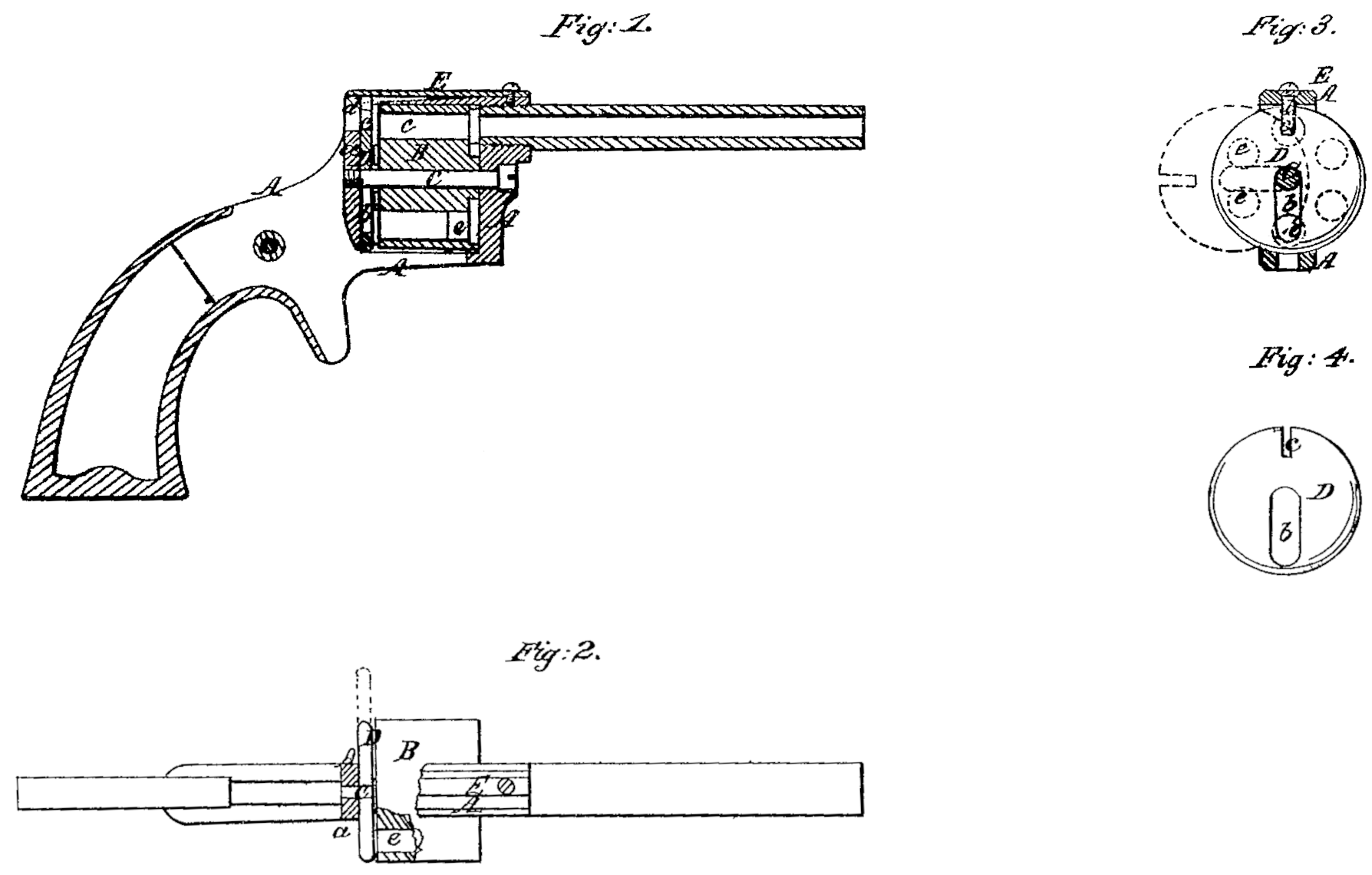US 30309
UNITED STATES PATENT OFFICE.
A. J. GIBSON, OF WORCESTER, MASSACHUSETTS.
IMPROVEMENT IN REVOLVING FIRE-ARMS.
Specification forming part of Letters Patent No. 30,309, dated October 9, 1860.
To all whom it may concern:
Be it known that I, A. J. Gibson, of Worcester, in the county of Worcester and State of Massachusetts, have invented a new and useful Improvement in Revolving Fire-Arms; and I do hereby declare that the following is a full, clear, and exact description of the same, reference being had to the accompanying drawings, forming part of this specification, in which—
Figure 1 is a central section of a pistol with my improvement. Fig. 2 is a top view of the same With part of the frame broken away. Fig. 3 is a transverse section of the same immediately in rear of the recoil-shield. Fig. 4 is a back view of the movable recoil-plate detached from the arm.
Similar letters of reference indicate corresponding parts in the several figures.
My invention consists in the employment, in combination with a cylinder having its chambers opening into its rear face, of a recoil-shield made separate from the frame of the arm and movable transversely thereto in such a manner as to expose the rear openings of the chambers to permit the insertion of cartridges thereat, the object being to make an arm of cheap construction and to obviate the necessity of either taking out the cylinder or opening the frame to insert the charges.
To enable others skilled in the art to make and use my invention, I will proceed to describe its construction and operation.
A is the frame, having its back part, a, no wider than the top, bottom, and front.
B is the chambered cylinder, arranged within the frame in the usual manner.
C is the fixed cylinder axis-pin, upon which the cylinder rotates, inserted through the front frame, and screwing tightly into a tapped hole in the rear thereof.
D is the transversely-movable recoil-plate, which constitutes my invention, of circular form, and having a radially-arranged slot, b, of a width equal to the diameter of the base-pin, and a notch, c, in its edge at the opposite side of its axis to the main portion of the slot b. The slot l extends from near the edge of the plate to a distance beyond its center equal to half the diameter of the axis-pin C. This recoil-plate fits snugly between the rear of the cylinder and the back part, a, of the frame, the axis-pin C passing through the slot b.
E is a spring attached to the top of the frame A and having rigidly attached to or formed in the same piece with it a tooth, d.
When the arm is in condition for firing, the recoil-plate D is concentric with the cylinder and the axis-pin, the inner end of the slot b resting on the pin, and the principal portion of the said slot below 1 t, the tooth d entering the notch c and preventing the plate turning, and the spring E pressing on the edge of the plate and holding the upper end of the slot down on the axis-pin, all as shown in black outline in Fig. 3, in which condition of the plate the rear ends of the chambers e e are all covered, and the cartridges, which are of the flanged kind commonly used with cylinders having the chambers open at the rear, are kept in place. When the arm is to be loaded the spring E is raised by the thumb or finger high enough to withdraw the tooth d out of the notch c, and the plate is turned in either direction to the extent of a quarter of a revolution and then drawn aside, in the manner shown in Fig. 3, as far as the slot b permits, leaving two chambers ex posed. By turning the cylinder while the plate is in this position to bring the chambers successively to positions to expose their rear ends all may be charged. When the chambers have all been charged the plate is first pushed back to a position concentric with the axis-pin and cylinder, which is as far as the slot l permits, and then turned back to the position first described, and represented in black in Fig.1, when the spring E drops down, with its tooth d, into the notch c and locks it. The notch c is deep enough for the hammer to strike through it below the tooth d of the spring E.
What I claim as my invention, and desire to secure by Letters Patent, is—
The transversely-movable recoil-plate D, applied in combination with the chambered cylinder, substantially as and for the purpose herein specified.
A. J. GIBSON.
Witnesses:
Appleton Dadmun,
W. G. King.

